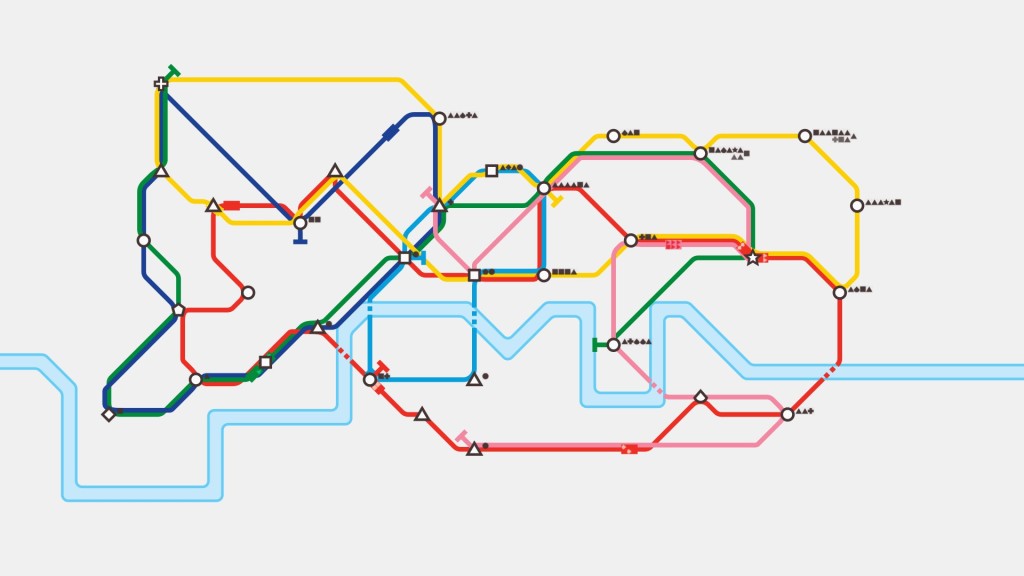MINI METRO
Dinosaur Polo Club
2015
PC, iOS/Android, Switch, PS4
Most games that get cited as “perfect” are either so purely gameplay that they can be modified to fit any aesthetic you want or require such a bizarre cocktail of ideas that they cannot be replicated in any other medium. Tetris is a beautiful game of mechanical perfection – the two best Tetris games of the 21st century, Tetris DS and Tetris Effect, transform the game in wildly different ways. The former, Tetris DS, is a celebration of Nintendo history with a Capsule Corporation menu aesthetic, borrowing sprites directly from NES classics including The Legend of Zelda and Metroid. The latter, Tetris Effect, sends Tetris into the new age stratosphere, with a sea of stars and a pulsing electronic soundtrack, a vibe somewhere between Burning Man and cult imagery. Alternatively, you can have the Super Mario franchise, where you have to cohere overall plumbers, giant turtles, extreme anime pop visuals, and ragtime or big band soundtracks – there is no dramatic “genre” or “mode” that this fantasy obviously fits, no game we play in real life that this matches beyond “pretend.”
Mini Metro illuminates the gap in this contrast by combining its pure gameplay with an immediately identifiable aesthetic that instantly teaches the player how to play it. The game takes place on a topographical railway map. Different shapes appear over time representing stations – each station starts receiving customers, represented by the station shape they’re trying to travel to. You draw rail lines between these stations (with just a drag and drop, easy as can be) and immediately trains start trafficking them along your drawn railway. Your goal is to keep the system running as long as possible before a station’s capacity overflows.
Drawing an effective railway is not simulated purely by distance, but also by the order you’ve drawn your stops – rerouting a line may result in a cleaner pathway that allows the train to take a turn smoothly rather than having to stop at a 180 and build speed again. Each in-game week, the city invests a little more funding – this can take the form of tunnels and bridges for crossing water features, additional trains to travel your rail lines, or additional lines of travel, each represented by their own bright color. The game comes down to drawing smart, efficient lines, and managing your choices in investment to protect yourself from accidentally hitting a dead end.
Designers could complicate this system and add currency for each rail line, add structural concerns for bridges about how long a carriage can cross safely, include “quality evaluations” along the way for earning extra bonuses from investment. But every decision in Mini Metro stems from the core concept of the aesthetically minimal topographical railway map. These ideas are not those represented visually on the map, and so they’re never introduced. Even the game’s soundtrack (by It Follows/Fez composer Disasterpeace) exists only in the forms of tones which play when passengers arrive or depart from a station.

What separates Mini Metro from other “perfect” video games in my mind is the fact that it so directly looks at a real world concept and adapts it into a compelling and legible game. For comparison, Tetris began as an imitation of a pentomino puzzle game – in a sense, that relates back to Tetris, but the game is also an imitation of other box filling games, not a real world phenomenon. It’s a signifier of a signifier, never quite reaching back to whatever the original meaning was. Shigeru Miyamoto came up with the concept of the Pikmin series because he’d gotten into the habit of gardening and liked imagining a little world in his garden – but the experience of commanding Pikmin as a small military and using them to perform a long-term scavenger hunt has almost nothing to do with gardening.
Development on this game started after a trip on London’s Underground – even if it hadn’t been London, it’s hard to imagine this game starting any other way. I’ve only encountered city train systems while traveling, and I still can so quickly understand what’s happening in the game because the gameplay is so well communicated by the iconic aesthetic. The railway map design allows the game to abstract more literal simulation without losing focus on the game’s actual intent, which is managing and designing an effective transit system. It’s a motivating game design philosophy, a reminder that play can be right in front of our noses rather than requiring the imagination to create a funny little plumber who shoots fireballs at kappa. Mini Metro is ingenious in the same way the George Dow and Harry Beck transit map model itself is ingenious, communicating where the trains go without literal geography, using easily recognized symbols to communicate importance, and using attractive bright colors that catch the eye and linger in memory.